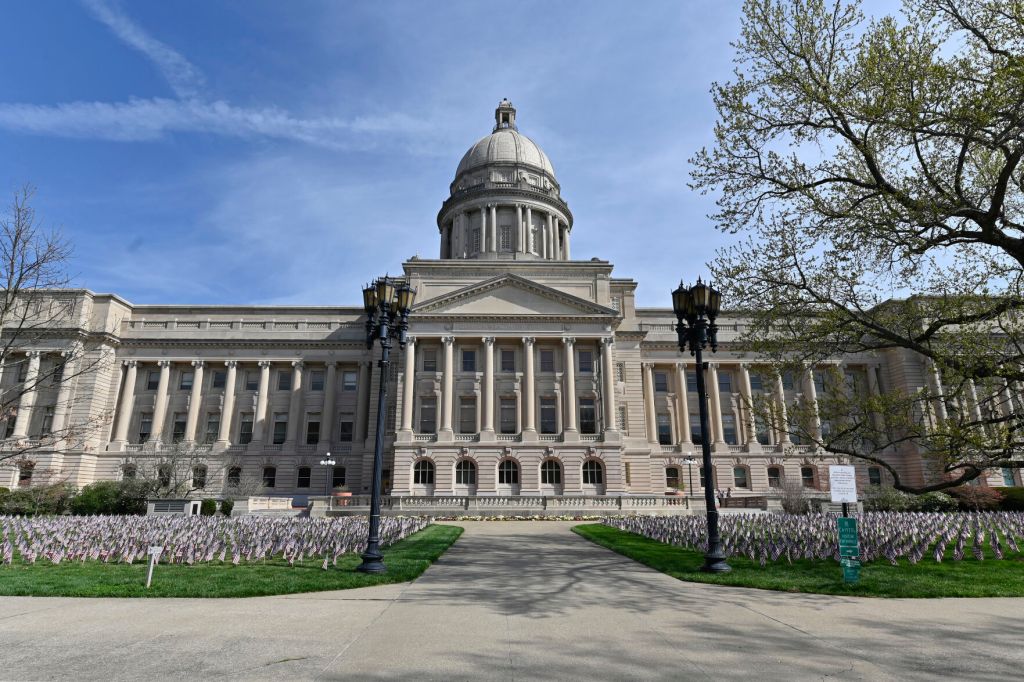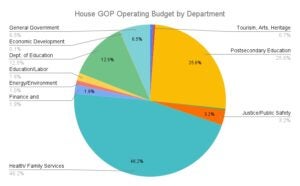House GOP presents budget, Gov. Beshear responds
Published 2:26 pm Friday, January 19, 2024

- Exterior photo of the Kentucky State Capitol in Frankfort in 2021.
FRANKFORT — This week, Kentucky House Republicans released their initial budget proposal.
It covers the two-year period from fiscal year 2024 to fiscal year 26.
Income tax reduction implications
The House Republican’s budget appropriates $1.73 billion of the Budget Reserve Trust Fund, commonly referred to as the “rainy day fund.”
All funding from the rainy day fund is dedicated to one-time expenses.
Some of the major budget items across the biennium include:
- $150 million to support drinking water and wastewater infrastructure grants;
- $450 million to the GRANT Program, which provides local governments and nonprofits with matching funds when applying for federal grants;
- $950 million toward unfunded pension liabilities of the state police, state employees and public teachers’ retirement systems;
- $575 million toward economic development projects and Kentucky’s Economic Development Finance Authority Loan Pool; and
- $34.9 million toward various transportation projects and grants.
The budget specifies that the appropriations coming from the rainy day fund will not be included in calculations for determining whether to further reduce the state income tax.
Since 2022, the legislature has embarked on an incremental journey to eliminate the income tax in Kentucky, one half percent reduction at a time.
In 2023, the income tax rate dropped from 5% to 4.5%, and this year, it dropped to 4%. However, last year, the budget did not meet the standards to cut the tax rate again to 3.5% in 2025.
To cut the rate, the budget has to meet two criteria. First, the amount of money in the rainy day fund has to be at least 10% of General Fund revenue in a given year.
Second, if the state’s spending via General Fund appropriations, plus the cost of a one percentage point drop in the income tax rate, is higher than the state’s revenue, it is not allowed to cut the income tax.
Essentially, lawmakers wanted to ensure that the state was bringing in more money than it was spending, with a large enough buffer for a rainy day.
The choice to not include rainy day fund appropriations in the calculation gives the legislature more room to meet the threshold for the next income tax rate cut.
Budget Overview
The state has several other pools of money to draw from in addition to the rainy day fund —the General Fund, made up of state revenue, federal funds and restricted funds, which are earmarked for specific purposes.
The House Republican’ operating budget includes a $99.8 billion operating budget, using $22.5 billion in General Fund dollars, $42.76 billion in federal funds, $28.1 billion in restricted funds and $112 million in road funds.
The operating budget covers day-to-day operations. The majority of the proposed budget would appropriate money for health and family services, including nearly $40 billion for Medicaid services.
The next highest share of funds goes to postsecondary education to support the state’s public colleges and universities. It includes KEES money, various tuition, grant and research programs, among many other things.

The House Republicans’ operating budget.
Its capital budget covers specific projects, and uses $5.8 million in general funds, $659 million in federal funds, $14.8 billion in restricted funds and $10.3 billion in funds from other sources.
Response to budget
Gov. Andy Beshear was visibly angry as he talked about the budget proposal at his weekly press conference on Thursday.
After a first look at the budget by his administration, he said he noticed quite a few items missing from the proposed budget.
The House budget increases base funding for SEEK, a formula that determines how state funds are distributed across school districts, from $4,200 per student to $4,455 per student in fiscal year 2026.
It also includes $127 million each year for local area vocational centers, $7.4 million per year for school based mental health service providers and $16.5 million each year for school resource officers.
Beshear said that despite those appropriations, his budget would have dedicated $1.1 billion more in SEEK funds, including a base funding raise, 11% raises for school employees, fully funded transportation and school resources like textbooks and technology.
While the House GOP budget suggests that school districts use state funds to give raises to their employees, Beshear said that only funding 80% of student transportation will make that difficult to impossible.
He said that schools will have to spend the money first on transportation, leaving little left over for potential raises.
Beshear was also concerned about the lack of funding for natural disaster recovery and preparation. The budget does not fund the East Kentucky Safe Fund, and limits the amount of money the state can use for emergencies and disasters.
If the state gets into a situation where they run out of this money, the legislature would have to enter a special session to appropriate the needed funds. Beshear said that is the last thing Kentucky needs to be worrying about in a natural disaster situation.
Lastly, Beshear said that the House GOP budget adds more red tape that would slow the work of the executive branch to a halt. It requires reports on all of his executive orders every 30 days, as well as quarterly reports for other executive branch actions.
It also cuts 95% of currently vacant positions in state personnel, at a time when the state government is trying to increase its workforce, Beshear said.
Beshear said that this “micromanagement” would prevent the executive branch from having the tools to enforce the laws that the legislature passes.
However, he said that it is early in the process, and he hopes to have conversations with House and Senate leadership to improve the budget by the end of the session.

